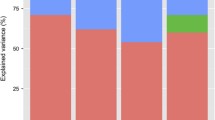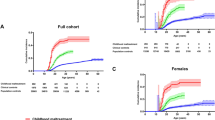Abstract
This study tests to see if different types of childhood abuse precede specific symptoms of schizophrenia. The analyses also examine for an interactive effect of hereditary risk, using family history of serious mental illness as a proxy variable. Data are taken from the cumulative anonymous records of patients with schizophrenia (N = 642) from a large state hospital in the northeastern U. S. Childhood abuse was separated into two domains: physical abuse and emotional/verbal abuse. Log-linear analysis of contingency tables uncovered a powerful pattern: risk for positive symptoms of schizophrenia is significantly elevated by two conditions: history of childhood abuse in combination with no history of serious mental illness within the family. The implications of these findings are discussed.
Similar content being viewed by others
References
Alda, M., Zvolsky, P., Dvorakova, M., & Papezova, H. (1991). Study of chronic schizophrenics with positive and negative family histories of psychosis. Acta Psychiatrica Scandinavica, 83, 334–337.
Álvarez, M., Roura, P., Osés, A., Foguet, Q., Solà, J., & Arrufat, F. (2011). Prevalence and clinical impact of childhood trauma in patients with severe mental disorders. The Journal of Nervous and Mental Disease, 199, 156–161.
American Psychiatric Association. (1987). Diagnostic and statistical manual of mental disorders (3rd ed.). Washington, DC: American Psychiatric Press.
Andreasen, N. C., & Olsen, S. (1982). Negative vs. positive schizophrenia: definition and validations. Archives of General Psychiatry, 29, 789–794.
Andreasen, N. C., Arrndt, A., Alliger, R., Miller, D., & Flaum, M. (1995). Symptoms of schizophrenia: methods, meaning and mechanisms. Archives of General Psychiatry, 52, 341–351.
Bendall, S., Jackson, H. J., Hulbert, C. A., & McGorry, P. D. (2008). Childhood trauma and psychotic disorders: a systematic, critical review of the evidence. Schizophrenia Bulletin, 34, 568–579.
Cardno, A. G., & Murray, R. M. (2003). The ‘classical’ genetic epidemiology of schizophrenia. In R. M. Murray, P. B. Jones, E. Susser, J. von Os, & M. Cannon (Eds.), The epidemiology of schizophrenia (pp. 195–219). Cambridge: Cambridge University Press.
Carr, A. (2000). Evidence-based practice in family therapy and systemic consultation I child focused problems. Journal of Family Therapy, 22, 29–60.
Chae, S., Sim, M., Lim, M., Na, J., & Kim, D. (2015). Multivariate analysis of relationship between childhood trauma and psychotic symptoms in patients with schizophrenia. Psychiatry Investigation, 13, 397–401.
Clarke, M. C., Tanskanen, A., Huttunen, M., Whittaker, J. C., & Cannon, M. (2009). Evidence for an interaction between familial liability and prenatal exposure to infection in the causation of schizophrenia. The American Journal of Psychiatry, 166, 1025–1030.
Dollfus, S., Ribeye, J. M., & Pettit, M. (1996). Family history and deficit form of schizophrenia. European Psychiatry, 11, 260–267.
Edwards, J., McGarry, P. D., Waddell, F. M., & Harrigan, S. M. (1999). Enduring negative symptom in first-episode psychosis: comparison of six methods using follow-up data. Schizophrenia Research, 40, 147–158.
Fenton, W. S., & McGlashan, T. H. (1994). Antecedents, symptom progression, of the deficit syndrome. American Journal of Psychiatry, 151, 351–356.
Fenton, W. S., McGlashan, T. H., Victor, B. J., & Blyer, C. R. (1997). Symptoms, subtype and suicidality in patients with schizophrenia spectrum disorders. American Journal of Psychiatry, 154, 199–204.
Fisher, H. L., Jones, P. B., & Fearon, P. (2010). The varying impact of type, timing and frequency of exposure to childhood adversity on its association with adult psychotic disorder. Psychological Medicine, 40, 1967–1978.
Fowles, D. C. (1992). Schizophrenia: diathesis-stress revisited. Annual Review of Psychology, 43, 303–336.
Gallagher, B. J., & Jones, B. J. (2013). Childhood stressors and symptoms of schizophrenia. Clinical Schizophrenia and Related Psychoses, 7, 124–130.
Gallagher, B. J., Jones, B. J., McFalls, J. A., & Pisa, A. M. (2006). Social class and type of schizophrenia. European Psychiatry, 21, 233–237.
Gallagher, B. J., Jones, B. J., McFalls, J. A., & Pisa, A. M. (2007). Schizophrenic subtypes, seasonality of birth and social class: a preliminary analysis. European Psychiatry, 22, 123–128.
Gallagher, B.J., Jones, B.J., Pardes, M. (2016) Stressful life events, social class and symptoms of schizophrenia. Clinical Schizophrenia and Related Psychoses.
Garety, P. A., Kuipers, E., Fowler, D., Freeman, D., & Bebbington, P. E. (2001). A cognitive model of the positive symptoms of psychosis. Psychological Medicine, 31, 189–195.
Goodman, L., Thompson, K., & Weinfurt, K. (1999). Reliability of violent victimization and PTSD among men and women with serious mental illness. Journal of Trauma and Stress, 12, 587–599.
Gottesman, I., & Shields, J. (1976). A critical review of recent adoption, twin and family studies of schizophrenia: behavioral genetics perspectives. Schizophrenia Bulletin, 2, 360–401.
Harrison, G. (2004). Trajectories of psychosis: Towards a new social biology of schizophrenia. Epidemiologia e Psichiatria Sociale, 13, 152–157.
Jones, B. J., Gallagher, B. J., Pisa, A., & McFalls, J. (2007). Social class, family history and type of schizophrenia. Psychiatry Research, 5, 245–248.
Kay, S. R., Fiszbein, A., & Opler, L. A. (1987). The positive and negative syndrome scale (PANSS) for schizophrenia. Schizophrenia Bulletin, 13, 261–276.
Kinderman, P. (2005). A psychology model of mental disorder. Harvard Review of Psychiatry, 13, 206–217.
Knoke, D., & Burke, P. (1980). Log-linear models. Beverly Hills: Sage Publications.
Krabbendam, L., Bak, M., Hanssen, M., Vollebergh, W., de Graff, R., & van Os, J. (2004). Childhood abuse as a risk factor for psychotic experiences. Acta Psychiatrica Scandinavica, 109, 38–45.
Lysaker, P. H., Meyer, P., Erans, J. D., & Marks, K. A. (2001). Neuro-cognitive and symptom correlates of self-reported childhood sexual abuse in schizophrenia spectrum disorders. Annals of Clinical Psychiatry, 13, 89–92.
Malla, A. K., Norman, R. M. G., & Manchanda, R. (2004). Can patients at risk for persistent negative symptoms be identified during their first episode of psychosis? Journal of Nervous and Mental Disease, 192, 455–463.
Matheson, S. L., Shepherd, A. M., Pinchbeck, R. M., Laurens, K. R., & Carr, V. J. (2013). Childhood adversity in schizophrenia: a systematic meta-analysis. Psychological Medicine, 43, 225–238.
McGlashan, T. H., & Fenton, W. S. (1992). The positive-negative distinction in schizophrenia. Archives of General Psychiatry, 49, 63–72.
Meyer, I., Muenzenmaier, K., Cancienne, J., & Struening, E. (1996). Reliability and validity of a measure of sexual and physical abuse histories among women with serious mental illness. Child Abuse and Neglect, 2, 213–219.
Miller, P., Lawrie, S. M., Hodges, A., Clafferty, R., Cosway, R., & Johnston, E. C. (2001). Genetic liability, illicit drug use, life stress and psychotic symptoms: preliminary findings from the Edinburgh study of people at high risk for schizophrenia. Social Psychiatry and Psychiatric Epidemiology, 36, 338–342.
Mortensen, P. B., Pedersen, C. B., Westergaard, T., Wohlfahrt, J., Ewald, H., Mors, O., Andersen, P. K., & Melbye, M. (1999). Effects of family history and place and season of birth on the risk of schizophrenia. New England Journal of Medicine, 340, 603–608.
Nale, M. C., & Kendler, K. S. (1995). Models of comorbidity for multifactorial disorders. American Journal of Human Genetics, 57, 935–953.
Nasrallah, H. A., & Weinberger, D. R. (1990). Neurology of schizophrenia. In H. A. Nasrallah & D. R. Weinberger (Eds.), Handbook of schizophrenia: I. Amsterdam: Elselvier.
Norman, R. M. G., & Malla, A. K. (1993). Stressful life events and schizophrenia II: conceptual and methodological issues. British Journal of Psychiatry, 162, 166–174.
Pallante, S., Quercioli, L., & Pazzagli, A. (1997). Relapse in young paranoid schizophrenic patients: a prospective study of stressful life events, p300 measures, and coping. American Journal of Psychiatry, 154, 792–798.
Read, J., Agar, K., Argyle, N., & Aderhold, V. (2003). Sexual and physical abuse during childhood and adulthood as predictors of hallucinations, delusions and thought disorder. Psychology and Psychotherapy: Theory, Research and Practice, 76, 1–22.
Read, J., van Os, J., Morrison, A. P., & Ross, C. A. (2005). Childhood trauma, psychosis and schizophrenia: a literature review with theoretical and clinical implications. Acta Psychiatrica Scandinavica, 112, 330–350.
Roy, M. A., Mèrette, C., & Maziade, M. (2011). Subtyping schizophrenia according to outcome or severity: a search for homogeneous subgroups. Schizophrenia Bulletin, 27, 115–138.
Rubino, I. A., Nanni, R. C., Pozzi, D. M., & Siracusano, A. (2009). Early adverse experiences in schizophrenia and unipolar depression. Journal of Nervous and Mental Disease, 197, 65–68.
Sar, V., Taycan, O., & Bolat, N. (2010). Childhood trauma and dissociation in schizophrenia. Psychopathology, 43, 33–40.
Schenkel, L. S., Spaulding, W. D., DiLillo, D., & Silverstein, S. M. (2005). Histories of childhood maltreatment in schizophrenia: relationships with premorbid functioning, symptomatology, and cognitive deficits. Schizophrenia Research, 76, 273–286.
Shevlin, M., Dorahy, M., & Adamson, G. (2007). Childhood traumas and hallucinations: an analysis of the national comorbidity survey. Journal of Psychiatric Research, 41, 222–228.
Sideli, L., Mule, A., La Barbera, D., & Murray, R. M. (2012). Do child abuse and maltreatment increase rick of schizophrenia? Psychiatry Investigation, 9, 87–99.
Tessner, K. D., Mittal, V., & Walker, E. F. (2001). Longitudinal study of stressful life events and daily stressors among adolescents at high risk for psychotic disorders. Schizophrenia Bulletin, 37, 432–441.
Tienari, P., Wynne, L. C., Laksy, K., Moring, J., Nieminen, P., Sorri, A., Lahti, I., & Wahlberg, K. E. (2003). Genetic Boundaries of the schizophrenia spectrum: evidence from the Finnish adoptive family study of schizophrenia. American Journal of Psychiatry, 160, 1587–1594.
Trotta, A., Murray, R., David, A., Kolliakou, A., O’Connor, J., Di Forti, M., Dazzan, P., Mondelli, V., Morgan, C., & Fisher, H. (2015). Impact of different childhood adversities on 1-year outcomes of psychotic disorder in the genetics and psychosis study. Schizophrenia Bulletin, 1–12.
van Os, J., & McGriffin, P. (2003). Can the social environment cause schizophrenia? British Journal of Psychiatry, 182, 291–292.
van Os, J., Hanssen, M., Bak, M., Bijl, R. V., & Vollebergh, W. (2003). Do urbanicity and familial liability coparticipate in causing psychosis? The American Journal of Psychiatry, 160, 477–482.
van Os, J., Krabbendam, L., Myin-Germeys, I., & Delespaul, P. (2005). The schizophrenia environe. Current Opinions in Psychiatry, 18, 141–145.
Varese, F., Smeets, F., Drukker, M., Lieverse, R., Lataster, L., Viechlbauer, W., Read, J., van Os, J., & Bentall, R. (2012). Childhoood adversities increase the use of psychosis: a meta-analysis of patient-control, prospective- and cross-sectional cohort studies. Schizophrenia Bulletin, 38, 661–671.
Vogel, M., Meier, J., & Grönke, S. (2011). Differential defects of childhood abuse and neglect: mediation by posttraumatic distress in neurotic disorder and negative symptoms in schizophrenia? Psychiatry Research, 189, 121–127.
Wahlberg, K. E., Wynne, L. C., Oja, H., Keskitalo, P., Pykäläimen, L., Lahti, I., Moring, J., Naarala, M., Sorri, A., Seitamaa, M., Laksy, K., Kolassa, J., & Tienari, P. (1997). Gene- environment interaction in vulnerability to schizophrenia: findings from the Finnish adoptive family study of schizophrenia. Americana Journal of Psychiatry, 154, 355–362.
Walker, E. F., & Diforio, D. (1997). Schizophrenia: a neural diathesis-stress model. Psychological Review, 104(4), 667–685.
Wicks, S., Hjern, A., & Dalman, C. (2010). Social risk or genetic liability for psychosis? a study of children born in Sweden and reared by adoptive parents. American Journal of Psychiatry, 167, 1240–1246.
Acknowledgments
We gratefully acknowledge the work of Marge DiLullo, Director of Medical Records at the state hospital for her painstaking efforts in collecting detailed clinical and social histories of the patients for us. This study is dedicated in her memory. We are also grateful to Sarah Spencer, Mariana Pardes and Denise Wilson for their technical and research support.
Author information
Authors and Affiliations
Corresponding author
Ethics declarations
Conflict of Interest
The authors declare that they have no conflict of interest.
Rights and permissions
About this article
Cite this article
Gallagher, B.J., Jones, B.J. Hereditary Risk and Child Abuse: Their Relative Roles in Type of Schizophrenia. Journ Child Adol Trauma 9, 255–261 (2016). https://doi.org/10.1007/s40653-016-0078-z
Published:
Issue Date:
DOI: https://doi.org/10.1007/s40653-016-0078-z




